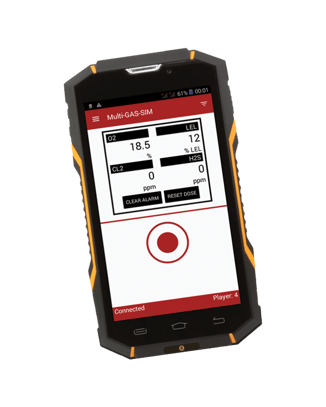.jpg?width=806&name=My%20project%20(8).jpg)
HazMat training for spill events can often include many challenging variables, including setting the time and location of the training, and sourcing the right materials for the target situation.
One of the most common challenges is determining which substances to use, and then balancing safety and regulatory requirements with maintaining a level of realism for your students. This means generating readings on the instruments used, which requires use of at least a small amount of the target substance.
While these substances can be implemented under strictly controlled conditions, this might affect the realism of readings on the detection equipment. This is especially the case for devices which respond to gases, oxygen displacement, and explosive atmospheres.
Additionally, certain conditions, such as those involving gas releases, are not feasible to use under most regulatory standards. Releasing gas for training is not unheard of in certain parts of the world which are less constrained by such regulations, but it is very uncommon and therefore unlikely that students will have the opportunity for real experience training using gas release.
This is why HazMat leak simulators are quickly becoming a popular option amongst instructors and teams. They allow for safe, real experience training under almost any condition.
In this post, we’ll take a closer look at how to use a leak simulator to train for spill events, and which options to consider.
Make A Comprehensive Plan For Your Training Exercise
Instructors and students often focus on the use of the detectors and the immediate scenario. However, there is always a bigger picture to consider. Some questions to ask before, during, and potentially after the exercise include:
- How are the readings being communicated?
- To whom are they communicated, and why?
- What decisions need to be made and by whom?
- What recommendations / advice should we provide and to who?
- Do we need to evacuate?
- Which other services or agencies do we need to inform and involve?
Thinking about the training event in a comprehensive way offers students the opportunity to practice with all aspects of command and control and responder / incident management.
→ Read more: An Introduction to HazMat Training
Source Materials To Use Alongside the Training Simulator
As with traditional HazMat leak simulator training, students and instructors should work

with the same materials they would use when responding to a real incident. This includes the correct personal protection equipment (PPE), communication devices, and the simulator detectors themselves. Additionally, instructors should source props to represent the incident. These might be as simple as damaged packaging or as complex as vehicles, waterborne vessels, and even retired aircraft.
Suggestions for Sourcing and Using HazMat Leak Simulators
While leak simulators can ensure that the student carrying the instrument experiences the readings appropriate for an exercise, not all simulators work the same, and some are more challenging to use than others.
For instance, some leak simulators require an instructor to enter the specific reading at each point in time by means of a control. This requires constant instructor management and operation.
Another approach uses wireless technology to represent the vapour leak. While this does not require ongoing instructor action, a wireless signal will penetrate materials which are impervious to gas, such as glass and brick. Readings will also relate to the distance from the simulated source of release and are unlikely to be able to simulate the effects of buoyancy.
To solve the challenges associated with gas release exercises, ultrasound has been found to be one of the most interesting and realistic options. Used in industry for leak detection, it has excellent vapour leak simulation characteristics. Ultrasound also helps instructors represent buoyancy by careful placement of the simulated leak emitters.
These approaches, however, while perfect for local area and internal leaks, can be limited in terms of release size.
Plume modelling software that is linked to a simulator with a Global Positioning System (GPS) can allow for a much wider exercise area. With this solution, readings are based upon a combination of the students’ locations and the simulated plume dispersion.
Utilising Argon’s HazMat Leak Simulators
A number of response organisations have been successfully using Argon simulators. During feedback, two of the most common benefits we hear are:
- The realism of the manner in which gas leakage through open windows and gaps at the base of doors is simulated, especially changes in readings when the opening increases.
- How effectively PlumeSIM and PlumeSIM-SMART simulates the manner in which a vapour cloud can shift in real time due to wind patterns.
→ Read more about our case studies here
Onboarding and implementing Argon’s HazMat leak simulators is straightforward, and works with a wide variety of systems.
Argon’s MultiGAS-SIM, for instance, operates through an interface module attached to Android smart mobile devices. Users can then access the interface via an app on the mobile device. Where implementation is easy and straightforward, the MultiGAS-SIM offers a wide range of customizability. It supports from one to a total of eight different simulation sensor types, including O2 and LEL. Instructors can configure the MultiGAS-SIM to incorporate specific simulation sensors as required to represent detectors with single or multiple sensor types. It also offers an optional Instructor Remote Controller (IRC) for remote student monitoring.
MultiGAS-SIM is also compatible with PlumeSIM, Argon’s world-leading wide-area CBRN / HazMat training system which provides management of chemical and radiological simulators. PlumeSIM allows instructors to select the parameters for the activation of simulation instruments (including the type of threat, release/delivery of single and multiple sources, and a full range of environmental conditions.) Instructors can also record the actions of trainees from a single location. 
Additionally, PlumeSIM-SMART provides the ability to deliver practical, engaging tabletop and live field HazMat release exercises through an app-based system. It allows instructors to safely and efficiently incorporate gaseously, HazMat, and other chemical threats, leaks, and releases.
Each of these training tools can significantly improve HazMat leak simulation exercises, with the ability to ensure Real Experience Training wherever and whenever needed.
By taking a comprehensive look at the training event’s goals, sourcing the right materials, and implementing leak simulators that work for you and your team, you can ensure that your next HazMat leak training exercise meets and exceeds learning goals.






